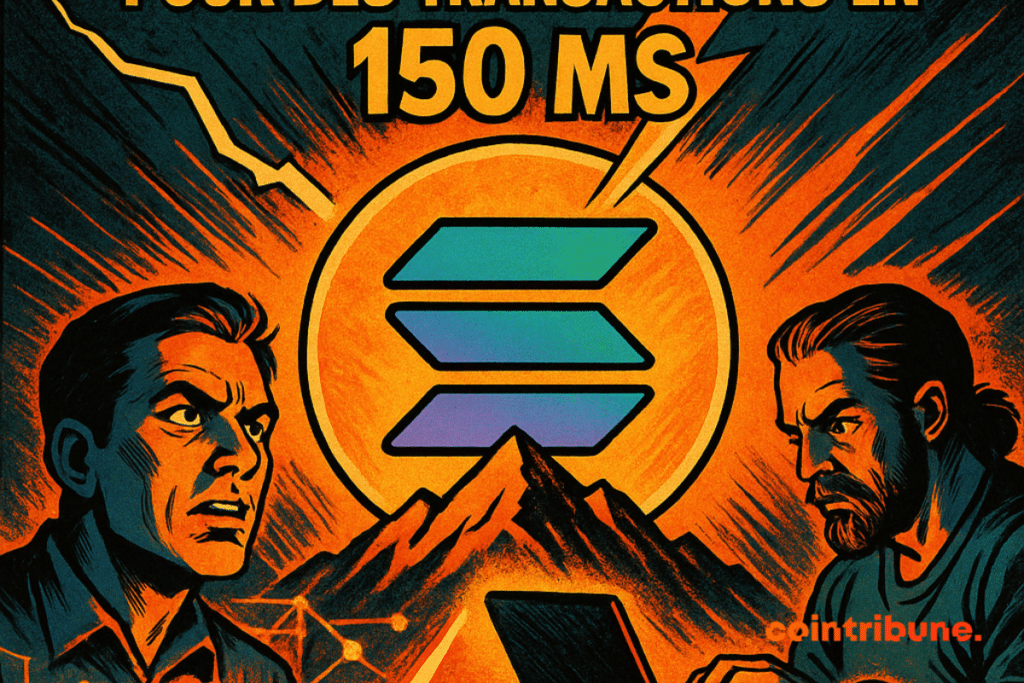Alpenglow: 99% of Voters Back Solana’s Lightning-Fast Upgrade
Solana has reached a decisive milestone with the massive approval of Alpenglow, an upgrade set to disrupt its operation. This decision paves the way for unprecedented acceleration of transactions, bringing the blockchain closer to the speeds of modern Internet infrastructure. Ecosystem players see this change as an opportunity to strengthen competitiveness against Ethereum and Bitcoin. Alpenglow thus marks the beginning of a new technological era for a network seeking to combine speed and reliability.

In brief
- Solana validated Alpenglow with over 99% votes, reducing transaction finality to 150 ms.
- The protocol introduces Votor and Rotor, two technical innovations designed to accelerate and optimize network consensus.
- Despite this progress, dependency on Agave requires caution, pending the arrival of Firedancer to strengthen resilience.
Unprecedented speed for transaction finality, driven by Solana.
The network voters massively supported Alpenglow. Thus, the Solana community must decide on the consensus overhaul, with over 99% of the votes cast in favor of the proposal. This update will reduce transaction finality time from 12.8 seconds to just 150 milliseconds, a historic change.
Such acceleration brings Solana closer to the speed of search engines and disrupts the competitive hierarchy in the blockchain space.
Anza, a company spun out of Solana Labs, unveiled the protocol and described it as a pioneering evolution. The governance process began on August 21 and has already crossed the threshold necessary to ensure its adoption.
The quorum set at 33% was reached quickly, confirming the strong interest of token holders in this proposal. Voting is expected to end in early September, but current data suggests Alpenglow is almost certain to be definitively adopted.
With this advancement, Solana aims to surpass Ethereum and Bitcoin in terms of speed and transactional responsiveness.
The two technical pillars: Votor and Rotor
The first pillar, named Votor, will manage vote processing and block finalization logic with high efficiency. This system will allow finalization in one round if 80% of validators participate, or in two rounds otherwise.
It will replace TowerBFT, the old protocol, deemed slower and less flexible for Solana’s future network growth.
The second pillar, Rotor, will optimize data propagation between network nodes, accelerating global state consensus. Rotor will replace the current proof-of-history mechanism, reducing synchronization delays among various validators.
Thanks to this innovation, Solana will be able to align with the performance of modern digital infrastructures with greater consistency.
These two components provide Solana with a considerable advantage, transforming its technical architecture into a model of speed and reliability. The whole shows that Solana seeks to establish an unprecedented standard in the first-layer blockchain industry.
Persistent challenges and future outlook
Despite this advance, Alpenglow will not completely solve the service interruptions that have already affected Solana.
The white paper highlights that dependency on a single client, Agave, still exposes the network to systemic vulnerabilities.
If a flaw occurs, the entire blockchain could experience significant disruptions, compromising user trust. To address this limitation, a new independent client called Firedancer will be launched on the mainnet by the end of the year.
Firedancer will diversify validation options and significantly reduce risks related to centralization on a single software.
The combination of Alpenglow and Firedancer will strengthen security while supporting the growth of an increasingly used network and a SOL that remains on the sidelines for now.
Maximize your Cointribune experience with our "Read to Earn" program! For every article you read, earn points and access exclusive rewards. Sign up now and start earning benefits.

Fascinated by Bitcoin since 2017, Evariste has continuously researched the subject. While his initial interest was in trading, he now actively seeks to understand all advances centered on cryptocurrencies. As an editor, he strives to consistently deliver high-quality work that reflects the state of the sector as a whole.
The views, thoughts, and opinions expressed in this article belong solely to the author, and should not be taken as investment advice. Do your own research before taking any investment decisions.